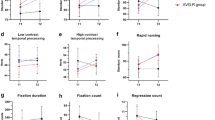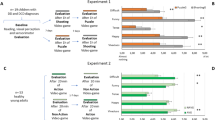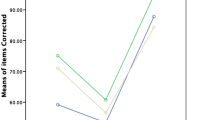Abstract
Purpose
To evaluate the effect of online visual games on the balance, visual perception, and oculomotor skills of children with developmental dyslexia during the COVID-19 pandemic.
Methods
In this single-blind randomized clinical trial, 50 children with developmental dyslexia, aged 7 to 11 years, were recruited from rehabilitation centers in Tehran, Iran, using a convenience sampling strategy. Participants were randomly divided into two groups: intervention (25) and control (25), with close matching based on sex, age, IQ, and type of disease. The interventions consisted of web-based online computer games focusing on visual perception and oculomotor skills. Outcome measures included the Test of Visual Perception Skills—Revised, the Pediatric Balance Scale, and videonystagmography. The Wechsler Intelligence Scale for Children—IV and the Reading and Dyslexia Test were used to evaluate IQ and reading skills, respectively.
Results
The intervention group exhibited significant post-intervention improvements in the Test of Visual Perception Skills—Revised, tracking gain, saccade latency, and saccade velocity scores (all P < 0.001). In contrast, the control group showed no significant differences in these tests in pre- and post-intervention (all P > 0.05). Notably, post-intervention comparisons between the groups revealed significant differences in smooth pursuit eye movements (P < 0.001), saccade latency (P = 0.027), and saccade velocity (P < 0.001). The Pediatric Balance Scale scores remained unchanged in both groups post-intervention (intervention: P = 0.317; control: P = 0.999). Game face validity was affirmed with impact scores above 1.5 for all items, suggesting that the games were straightforward, clear, and relevant.
Conclusion
Online visual games enhanced oculomotor and visual perception skills in children with dyslexia but did not influence balance skills.


Similar content being viewed by others
References
Knight C (2018) What is dyslexia? An exploration of the relationship between teachers’ understandings of dyslexia and their training experiences. Dyslexia 24(3):207–219
Wagner RK, Zirps FA, Edwards AA, Wood SG, Joyner RE, Becker BJ et al (2020) The prevalence of dyslexia: a new approach to its estimation. J Learn Disabil 53(5):354–365
Sedaghati L, Foroughi R, Shafiei B, Maracy MR (2010) Prevalence of dyslexia in first to fifth grade elementary students Isfahan. Iran Audiol 19(1):94–101
Yavari A, Valizadeh A, Maroufizadeh S, Panahian M (2019) The prevalence of dyslexia among school age Persian speaking students in Arak. Iran Iran Funct Disabil J 2(1):1–5
Gori S, Seitz AR, Ronconi L, Franceschini S, Facoetti A (2016) Multiple causal links between magnocellular–dorsal pathway deficit and developmental dyslexia. Cereb Cortex 26(11):4356–4369
Boets B, Vandermosten M, Cornelissen P, Wouters J, Ghesquière P (2011) Coherent motion sensitivity and reading development in the transition from prereading to reading stage. Child Dev 82(3):854–869
Eden G, Stein J, Wood H, Wood F (1994) Differences in eye movements and reading problems in dyslexic and normal children. Vis Res 34(10):1345–1358
Kirkby JA, Webster LA, Blythe HI, Liversedge SP (2008) Binocular coordination during reading and non-reading tasks. Psychol Bull 134(5):742
Bucci MP, Brémond-Gignac D, Kapoula Z (2008) Poor binocular coordination of saccades in dyslexic children. Graefes Arch Clin Exp Ophthalmol 246(3):417–428
Vidyasagar TR, Pammer K (2010) Dyslexia: a deficit in visuo-spatial attention, not in phonological processing. Trends Cogn Sci 14(2):57–63
Valdois S, Bidet-Ildei C, Lassus-Sangosse D, Reilhac C, N’guyen-Morel M-A, Guinet E et al (2011) A visual processing but no phonological disorder in a child with mixed dyslexia. Cortex. 47(10):1197–1218
Nicolson RI, Fawcett AJ (2007) Procedural learning difficulties: Reuniting the developmental disorders? Trends Neurosci 30(4):135–141
Nicolson RI, Fawcett AJ, Berry EL, Jenkins IH, Dean P, Brooks DJ (1999) Association of abnormal cerebellar activation with motor learning difficulties in dyslexic adults. Lancet 353(9165):1662–1667
Vieira S, Quercia P, Michel C, Pozzo T, Bonnetblanc F (2009) Cognitive demands impair postural control in developmental dyslexia: a negative effect that can be compensated. Neurosci Lett 462(2):125–129
Eden GF, VanMeter JW, Rumsey JM, Zeffiro TA (1996) The visual deficit theory of developmental dyslexia. Neuroimage 4(3):108–117
Stein J, Walsh V (1997) To see but not to read; the magnocellular theory of dyslexia. Trends Neurosci 20(4):147–152
Peterson RL, Pennington BF (2012) Developmental dyslexia. Lancet 379(9830):1997–2007
De Luca M, Di Pace E, Judica A (1993) Eye movements patterns in linguistic and non-linguistic tasks in developmental surface dyslexia. Neurosychologia 37(12):1407–1420
Bucci MP (2021) Visual training could be useful for improving reading capabilities in dyslexia. Appl Neuropsychol Child 10(3):199–208
Stein J (2018) What is developmental dyslexia? Brain Sci 8(2):26
Simos PG, Fletcher JM, Bergman E, Breier J, Foorman B, Castillo E et al (2002) Dyslexia-specific brain activation profile becomes normal following successful remedial training. Neurology 58(8):1203–1213
Richards TL, Corina D, Serafini S, Steury K, Echelard DR, Dager SR et al (2000) Effects of a phonologically driven treatment for dyslexia on lactate levels measured by proton MR spectroscopic imaging. Am J Neuroradiol 21(5):916–922
Temple E, Deutsch GK, Poldrack RA, Miller SL, Tallal P, Merzenich MM et al (2003) Neural deficits in children with dyslexia ameliorated by behavioral remediation: evidence from functional MRI. Proc Natl Acad Sci 100(5):2860–2865
Kujala T, Karma K, Ceponiene R, Belitz S, Turkkila P, Tervaniemi M et al (2001) Plastic neural changes and reading improvement caused by audiovisual training in reading-impaired children. Proc Natl Acad Sci 98(18):10509–10514
Schulte-Körne G, Deimel W, Bartling J, Remschmidt H (1998) Auditory processing and dyslexia: evidence for a specific speech processing deficit. NeuroReport 9(2):337–340
Näätänen R, Schröger E, Karakas S, Tervaniemi M, Paavilainen P (1993) Development of a memory trace for a complex sound in the human brain. Neuroreport Int J Rapid Commun Res Neurosci
Recanzone GH, Schreiner CE, Merzenich MM (1993) Plasticity in the frequency representation of primary auditory cortex following discrimination training in adult owl monkeys. J Neurosci 13(1):87–103
Ahissar E, Vaadia E, Ahissar M, Bergman H, Arieli A, Abeles M (1992) Dependence of cortical plasticity on correlated activity of single neurons and on behavioral context. Science 257(5075):1412–1415
Shahbodin F, Mohd CKNCK, Azni A, Jano Z (eds) (2019) Visual perception games for autistic learners: research findings. In: Proceedings of the 2019 Asia Pacific information technology conference
Zhang J, Lyu Y, Wang Y, Nie Y, Yang X, Zhang J, et al., editors. Development of laparoscopic cholecystectomy simulator based on unity game engine. In: Proceedings of the 15th ACM SIGGRAPH European conference on visual media production; 2018.
Vilaça J, Duque D (eds) (2019) Diagnosis of children’s vision problems through video games: case study: a visual acuity test & game tool. In: 2019 IEEE 7th international conference on serious games and applications for health (SeGAH). IEEE
Rello L, Kanvinde G, Baeza-Yates R (2012) A mobile application for displaying more accessible ebooks for people with dyslexia. Procedia Comput Sci 14(1):226–233
Tomé RM, Pereira JM, Oliveira M (eds) (2014) Using serious games for cognitive disabilities. In: International conference on serious games development and applications. Springer
Peters JL, De Losa L, Bavin EL, Crewther SG (2019) Efficacy of dynamic visuo-attentional interventions for reading in dyslexic and neurotypical children: a systematic review. Neurosci Biobehav Rev 100(1):58–76
Ramsay MW, Davidson C, Ljungblad M, Tjärnberg M, Brautaset R, Nilsson M (2014) Can vergence training improve reading in dyslexics? Strabismus 22(4):147–151
Peyre H, Gérard C, Vanderhorst D, Larger S, Lemoussu C, Vesta J et al (2017) Computerized oculomotor training in dyslexia: a randomized, crossover clinical trial in pediatric population. L’encephale 44(3):247–255
Jafarlou F, Jarollahi F, Ahadi M, Sadeghi-Firoozabadi V, Haghani H (2017) Oculomotor rehabilitation in children with dyslexia. Med J Islam Repub Iran 31(1):125
Rochelle KS, Talcott JB (2006) Impaired balance in developmental dyslexia? A meta-analysis of the contending evidence. J Child Psychol Psychiatry 47(11):1159–1166
Bucci MP, Mélithe D, Ajrezo L, Bui-Quoc E, Gérard C-L (2014) The influence of oculomotor tasks on postural control in dyslexic children. Front Hum Neurosci 8(981):1–32
Kapoula Z, Bucci MP (2007) Postural control in dyslexic and non-dyslexic children. J Neurol 254(9):1174
Shokoohi-Yekta M, Lotfi S, Rostami R, Akbar Arjmandnia A, Motamed-Yeganeh N, Sharifi A (2014) The effectiveness of computerized cognitive training on the working memory performance of children with dyslexia. Audiology 23(3):1–10
Association AP (2013) Diagnostic and statistical manual of mental disorders (DSM-5®). American Psychiatric Publication
Dehghan A (2004) Standardization of test of visual perceptual skills in normal children aged 7 to 9 years in Tehran City: Thesis]. Tehran. Rehabilitation and Welfare University
Khayat-Zadeh Mahani M, Mardani-Shahrbabak BA, Gholamian HR, Rahgozar M, Soroury MH, Fadaie F (2011) Visual perceptual skills in normal children aged 7 to 13 years in Tehran city. Arch Rehabil 11(4):8–14
Franjoine MR, Gunther JS, Taylor MJ (2003) Pediatric balance scale: a modified version of the berg balance scale for the school-age child with mild to moderate motor impairment. Pediatr Phys Ther 15(2):114–128
Alimi E, Kalantari M, Nazeri A-R, Baghban AA (2019) Test-retest & inter-rater reliability of Persian version of pediatric balance scale in children with spastic cerebral palsy. Iran J Child Neurol 13(4):163
Chen C-L, Shen I-H, Chen C-Y, Wu C-Y, Liu W-Y, Chung C-Y (2013) Validity, responsiveness, minimal detectable change, and minimal clinically important change of Pediatric Balance Scale in children with cerebral palsy. Res Dev Disabil 34(3):916–922
Abdollahipour F, Alizade ZM, Akbarfahimi M, Karamali ES (2016) Study of face and content validity of the Persian version of behavior rating inventory of executive function, preschool version
Mohammadbeigi A, Mohammadsalehi N, Aligol M (2015) Validity and reliability of the instruments and types of measurements in health applied researches. J Rafsanjan Univ Med Sci 13(12):1153–1170
Rodán-González AV-L, Javaloyes-Moreno J, Muiños-Durán B, Rifá-Giribet M, García-Montero M, Gimeno-Galindo M, et al Figura-Fondo. https://saerainternational.com/shop/free-download/324-training-activities-for-visual-perceptual-skills-figure-ground-basic-level.html
Codina-Fossas M V-LJ, Roden-Gonzalez A, García-Montero M. https://saerainternational.com/shop/free-download/328-training-activities-for-visual-perceptual-skills-visual-discrimination-basic-level.html
Muinos-Duran M, Vidal-Lopez J, Roden-Gonzalez A, Rifa-Gribet M, Gimeno-Galindo P, Javaloyes-Moreno B. Training activities for visual-perceptual skills visual closure (basic level). https://saerainternational.com/shop/courses/310-training-activities-for-visual-perceptual-skills-visual-closure-basic-level.html. Accessed 12 Sept 2014.
Javaloyes-Moreno BV-L, Rodán-González J, Muiños-Durán A, Rifá-Giribet M, Codina-Fossas M, García-Montero M, et al Ejerciicos de Ubicacion Espacial https://saerainternational.com/shop/free-download/330-training-activities-for-visual-perceptual-skills-visual-spatial-relationships-basic-level.html
Rifá-Giribet MV-L, Rodán-González J, Codina-Fossas A, García-Montero M, Gimeno-Galindo M, Javaloyes-Moreno P, et al Memoria Visual https://saerainternational.com/shop/free-download/329-training-activities-for-visual-perceptual-skills-visual-memory-basic-level.html
Pettersen HH (2018) Design and development of game-based oculomotor training using eye tracking. The University of Bergen
Bucci M, Carzola B, Fiucci G, Potente C, Caruso L (2018) Computer based oculomotor training improves reading abilities in dyslexic children: results from a pilot study. Sports Inj Med 2
Bucci MP, Gerard CL, Bui-Quoc E (2013) The effect of a cognitive task on the postural control of dyslexic children. Res Dev Disabil 34(11):3727–3735
Legrand A, Bui-Quoc E, Doré-Mazars K, Lemoine C, Gérard CL, Bucci MP (2012) Effect of a dual task on postural control in dyslexic children. PLoS ONE 7(4):1–6
Goulème N, Gérard CL, Bucci MP (2015) The effect of training on postural control in dyslexic children. PLoS ONE 10(7):e0130196
Mahvash-Vernosfaderani A, Parhoon K, Pooshaneh K (2016) The effectiveness of sensory-motor integration on balance and reading performance in children with dyslexia. J Res Behav Sci 14(2):257–263
Stenico MB, Capellini SA (2013) Visual perceptual skills and writing quality of students with dyslexia. Revista Psicopedagogia 30(93):169–176
Bosse M-L, Tainturier MJ, Valdois S (2007) Developmental dyslexia: The visual attention span deficit hypothesis. Cognition 104(2):198–230
Fusco N, Germano GD, Capellini SA (eds) (2015) Efficacy of a perceptual and visual-motor skill intervention program for students with dyslexia. CoDAS, SciELO Brasil
Lin H-C, Chiu Y-H, Chen YJ, Wuang Y-P, Chen C-P, Wang C-C et al (2017) Continued use of an interactive computer game-based visual perception learning system in children with developmental delay. Int J Med Inform 107(1):76–87
Gori S, Facoetti A (2015) How the visual aspects can be crucial in reading acquisition: the intriguing case of crowding and developmental dyslexia. J Vis 15(1):8
Hutzler F, Kronbichler M, Jacobs AM, Wimmer H (2006) Perhaps correlational but not causal: no effect of dyslexic readers’ magnocellular system on their eye movements during reading. Neuropsychologia 44(4):637–648
Fischer B, Hartnegg K (2000) Effects of visual training on saccade control in dyslexia. Perception 29(5):531–542
Eden GF, VanMeter JW, Rumsey JM, Maisog JM, Woods RP, Zeffiro TA (1996) Abnormal processing of visual motion in dyslexia revealed by functional brain imaging. Nature 382(6586):66–69
Galaburda A, Livingstone M (1993) Evidence for a magnocellular defect in developmental dyslexia a. Ann N Y Acad Sci 682(1):70–82
Ward LM, Kapoula Z (2020) Differential diagnosis of vergence and saccade disorders in dyslexia. Sci Rep 10(1):1–15
Ross J, Morrone MC, Goldberg ME, Burr DC (2001) Changes in visual perception at the time of saccades. Trends Neurosci 24(2):113–121
Bucci MP, Nassibi N, Gerard CL, Bui-Quoc E, Seassau M (2012) Immaturity of the oculomotor saccade and vergence interaction in dyslexic children: evidence from a reading and visual search study. PLoS ONE 7(3):1–8
Kinsey K, Rose M, Hansen P, Richardson A, Stein J (2004) Magnocellular mediated visual-spatial attention and reading ability. NeuroReport 15(14):2215–2218
Posner MI, Cohen Y (1984) Components of visual orienting. Atten Perform X Control Lang Process 32(1):531–556
Funding
The authors declare that no funds, grants, or other support were received during the preparation of this manuscript.
Author information
Authors and Affiliations
Contributions
All authors contributed to the study conception and design. Material preparation, data collection, and analysis were performed by NC and HD. The first draft of the manuscript was written by NC and HD and all authors commented on previous versions of the manuscript. All authors read and approved the final manuscript.
Corresponding author
Ethics declarations
Conflict of interest
The authors declare that they have no conflict of interest.
Additional information
Publisher's Note
Springer Nature remains neutral with regard to jurisdictional claims in published maps and institutional affiliations.
Rights and permissions
Springer Nature or its licensor (e.g. a society or other partner) holds exclusive rights to this article under a publishing agreement with the author(s) or other rightsholder(s); author self-archiving of the accepted manuscript version of this article is solely governed by the terms of such publishing agreement and applicable law.
About this article
Cite this article
Dalvand, H., Chamani, N., Rahsepar-Fard, K. et al. The effect of online visual games on visual perception, oculomotor, and balance skills of children with developmental dyslexia during the COVID-19 pandemic. Int Ophthalmol 43, 5011–5024 (2023). https://doi.org/10.1007/s10792-023-02904-x
Received:
Accepted:
Published:
Issue Date:
DOI: https://doi.org/10.1007/s10792-023-02904-x




